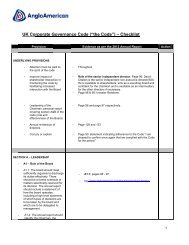pdf [ 1.1MB ] - Anglo American
pdf [ 1.1MB ] - Anglo American
pdf [ 1.1MB ] - Anglo American
You also want an ePaper? Increase the reach of your titles
YUMPU automatically turns print PDFs into web optimized ePapers that Google loves.
Above: Joseph Thibles, anoperator at the Kromdraailiming plant, tests waterfrom the old undergroundworkings and pit.Above left: Developmentof the Emalahleni waterreclamation project’s125m 3 /day desalinationdemonstration plant and,below, an aerial view ofthe Emalahleni watertreatment plant underconstruction.by the DWAF. During the year, the colliery alsoreceived permission from the DWAF to increase itswater pumping capacity from other undergroundsources to 20Ml/day.Limited rainfall during the previous two wetseasons has resulted in low flows in the Olifantsriver. As a consequence, the river has had noassimilative capacity and no controlled releasesfrom the collieries have been permitted by theDWAF during 2005.BiodiversityBaseline biodiversity action plans (BAPs) havebeen developed and implemented at all operatingcollieries.<strong>Anglo</strong> Coal South Africa nominated itsGoedehoop and Kriel collieries for an <strong>Anglo</strong><strong>American</strong> plc BAP peer review. The main findingsof this review were:oooobiodiversity management requires the formalallocation of biodiversity conservationresponsibilities to colliery staff;there is a need for better stakeholderengagement;internal audits and external verification of theseneed to be implemented; andthe need to develop a stronger business casefor biodiversity conservation.The lessons learned from this review processwill be implemented at all operations during 2006.Land rehabilitation<strong>Anglo</strong> Coal South Africa has about 106,000hectares under its charge, including land leased andowned. Of this land, 14% has been altered bymining activities, and of this altered land 11% hasbeen fully rehabilitated. Although the division begana colliery closure fund as early as 1972, ongoingrehabilitation is provided for in working costs.Greenhouse gas emissionsThe National Environmental Management AirQuality Act (Act 39 of 2004) was partiallyimplemented on 11 September 2005. Through thisAct, the Vaal Triangle area (which includes NewVaal colliery) has been declared a priority airpollution area by the Minister of EnvironmentalAffairs and Tourism. This is expected to placepressure on all industrial sectors to reduce pollution.Carbon dioxide and methane are the twogreenhouse gas elements with which the divisionis most concerned. Basic emissions statistics areprovided in the table below.C0 2 from source in tonnes2004 2005CO 2 e production fromelectricity purchased 725,000* 773,000CO 2 e production fromprocesses and fossil fuels 121,000* 165,000CO 2 e productionfrom methane 298,000 232,000Total CO 2 eproduction 1,144,000 1,171,000* These figures have been restatedMethane emissions> South African coalgenerally has a lower methane content than coalfrom European and Australian coalfields. This wastaken into account in 2001 when the methanelevels were predicted using the IPCC guidelines.As no reliable tool has been available for the quantificationof actual emissions, three investigations wereundertaken during 2004/2005 to quantify methaneemissions from normal operations at the collieriesand from spontaneous combustion.The three studies found that:omeasured samples of methane emissionswere far lower than those estimated usingthe IPCC guidelines;27


![pdf [ 1.1MB ] - Anglo American](https://img.yumpu.com/49057963/29/500x640/pdf-11mb-anglo-american.jpg)
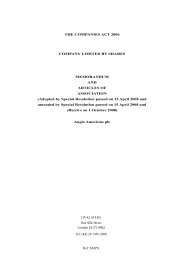
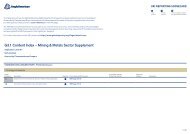
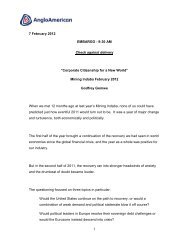
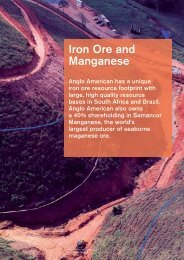
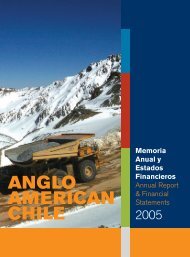
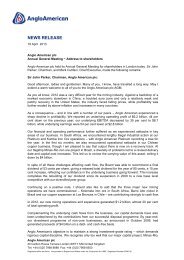
![English PDF [ 189KB ] - Anglo American](https://img.yumpu.com/50470814/1/184x260/english-pdf-189kb-anglo-american.jpg?quality=85)
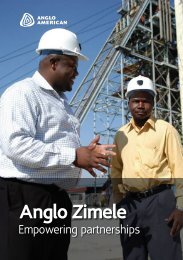

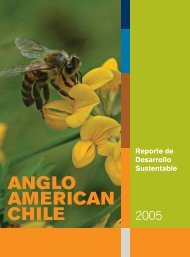

![pdf [ 595KB ] - Anglo American](https://img.yumpu.com/49420483/1/184x260/pdf-595kb-anglo-american.jpg?quality=85)
